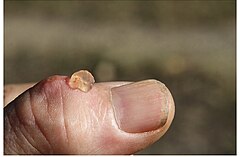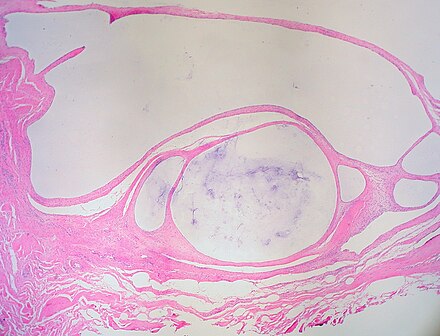Ganglion Cyst
A ganglion cyst is a fluid-filled bump associated with a joint or tendon sheath. It is most commonly found on the back of the wrist, although it can also appear on the front of the wrist, hand, foot, knee, shoulder, and other joints. The cause is unknown, but the condition is believed to involve an outpouching of the synovial membrane.

Presentation
Ganglion cysts are typically small, soft bumps that are associated with a joint or tendon sheath. The average size is about 2 centimetres, although larger cysts have been reported. The size may vary over time. They account for 50-70% of all masses on the hand and wrist.
Wrist
Common locations for wrist ganglions include:
- Dorsal wrist ganglion
- Volar wrist ganglion
- Extensor retinaculum ganglion
- Occult ganglion
- Intraosseous ganglion
- Mucous cyst
Foot
A 2007 study in Glasgow found that 39 of 101 surgically removed foot lumps were ganglion cysts. These cysts were notably absent from the sole or heel, suggesting that lumps in these areas should prompt consideration of other diagnoses. The study also noted a higher occurrence in females (85%).
Other Locations
Ganglion cysts can form near the knee, shoulder, and other joints. Rarely, intraosseous ganglion cysts can occur within the bone, sometimes in combination with a cyst in the overlying soft tissue. Intramuscular ganglion cysts in the gastrocnemius muscle and cysts intruding into the spine have also been reported.






Causes
The most accepted cause of ganglion cysts is the herniation hypothesis, which suggests that they occur as an out-pouching of a weakened portion of a joint capsule or tendon sheath. This hypothesis is supported by the fact that cysts occur close to tendons and joints, and the fluid within the cysts is similar to synovial fluid. Other possible mechanisms include repeated mechanical stress, facet arthrosis, myxoid degeneration, and increased production of hyaluronic acid by fibroblasts.
Diagnosis
Ganglion cysts are usually diagnosed based on their visible appearance and pliability to touch. Ultrasonography (US) can be used to increase diagnostic confidence, especially for smaller "occult" cysts.

Treatment
At least 33% of ganglion cysts resolve without treatment within six years, and 50% within 10 years. Treatment options include watchful waiting, splinting the affected joint, needle aspiration, and surgery. Surgical excision is the primary elective treatment option, but the recurrence rate is about 50% following aspiration.
Complications
Complications of treatment may include joint stiffness, scar formation, and recurrence of the cyst. Recurrence is more common following excision of a volar ganglion cyst in the wrist and incomplete excision that fails to include the stalk or pedicle.
Prognosis
Recurrence rates are higher in aspirated cysts than in excised ones. A six-year study found that 58% of untreated ganglion cysts resolved spontaneously, with postsurgery recurrence rates at 39%. A similar study on palmar wrist ganglions found no difference in symptoms between excised, aspirated, and untreated cysts at 2- and 5-year follow-ups.
Etymology
The term "ganglion cyst" comes from the ancient Greek "γάγγλιον," meaning "knot" or "swelling beneath the skin." Historically, these cysts were treated by striking them with a large book, often a Bible, leading to the nickname "Bible bumps." This practice is not recommended due to the risk of injury.
Self-assessment MCQs (single best answer)
Where are ganglion cysts most commonly found?
What is the average size of a ganglion cyst?
Which of the following is NOT a common location for wrist ganglions?
According to a 2007 study in Glasgow, what percentage of surgically removed foot lumps were ganglion cysts?
Which hypothesis is most accepted as the cause of ganglion cysts?
Which diagnostic tool can be used to increase confidence in diagnosing smaller "occult" ganglion cysts?
What percentage of ganglion cysts resolve without treatment within six years?
Which treatment option for ganglion cysts has a recurrence rate of about 50% following aspiration?
What complication is NOT commonly associated with the treatment of ganglion cysts?
What historical method was used to treat ganglion cysts, leading to the nickname "Bible bumps"?
Dentaljuce
Dentaljuce provides Enhanced Continuing Professional Development (CPD) with GDC-approved Certificates for dental professionals worldwide.
Founded in 2009 by the award-winning Masters team from the School of Dentistry at the University of Birmingham, Dentaljuce has established itself as the leading platform for online CPD.
With over 100 high-quality online courses available for a single annual membership fee, Dentaljuce offers comprehensive e-learning designed for busy dental professionals.
The courses cover a complete range of topics, from clinical skills to patient communication, and are suitable for dentists, nurses, hygienists, therapists, students, and practice managers.
Dentaljuce features Dr. Aiden, a dentally trained AI-powered personal tutor available 24/7 to assist with queries and provide guidance through complex topics, enhancing the learning experience.
Check out our range of courses, or sign up now!


